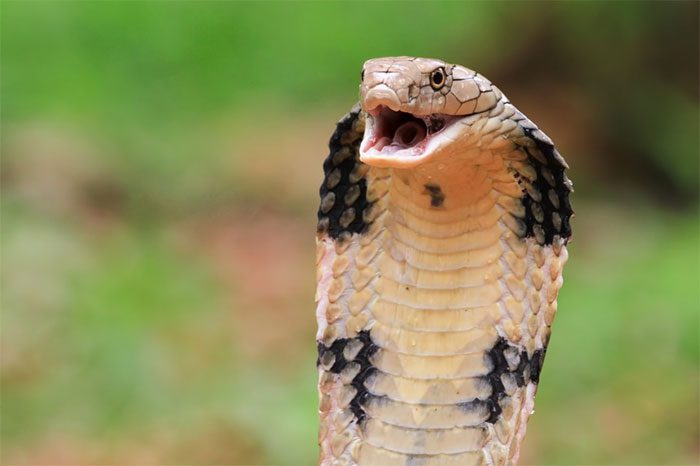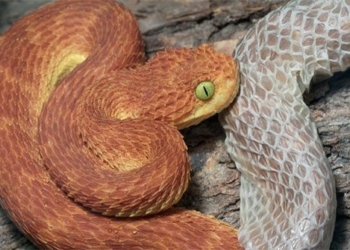The venom of the king cobra contains potent toxins that can paralyze the nervous system and respiratory center of the brain, causing the victim to die from asphyxiation and heart failure.
Shy Creatures
According to National Geographic, the king cobra can grow up to 5.5 meters long, making it the longest venomous snake in the family of snakes.
This species primarily inhabits tropical rainforests and plains in India, southern China, and Southeast Asia. They thrive in various habitats such as dense forests, bamboo thickets, mangrove swamps, high grasslands, and rivers.
The king cobra is one of the most venomous snakes on the planet. Unlike many other snakes that can only crawl, the king cobra can raise one-third of its body off the ground and stare directly into the eyes of its adversary.
When feeling threatened, they can lift themselves up while advancing forward to attack.
However, the king cobra is a very shy species and will avoid humans whenever possible. They only attack when provoked or stepped on.
Another easily noticeable characteristic of the king cobra is its flared head, which produces a hiss similar to a dog growling.

When feeling threatened, the king cobra will raise itself and look into the eyes of its enemy. (Photo: Freepik).
The Most Venomous Terrestrial Snake in Vietnam
Dr. Le Quoc Hung, Head of the Tropical Diseases Department at Cho Ray Hospital (Ho Chi Minh City), states that the king cobra is the most venomous terrestrial snake in Vietnam.
The venom of the king cobra is not the strongest among venomous snakes, but it contains numerous neurotoxins and cytotoxins. These substances, when acting on the respiratory centers in the brain, can cause the victim to stop breathing and experience heart failure.
Consequently, a single bite can deliver enough venom to kill 20 people or even an elephant.
According to Dr. Hung, when bitten by a king cobra, the wound site may swell, progressing to blisters. The bite is usually very painful, and the surrounding skin often turns dark purple or black. At this stage, the tissues may begin to die, leading to necrosis. This damage can spread over several days and form a border around the bite.
The victim may experience swelling and pain in lymph nodes such as the axillary, groin, and elbow areas near the bite.
Paralysis typically occurs 3 to 20 hours after being bitten. Symptoms can range from drooping eyelids, sore throat, difficulty speaking, limited mouth opening, and phlegm accumulation to more severe conditions, including respiratory muscle paralysis, limb paralysis, hypotension, nausea, abdominal pain, acute kidney failure, and even death.
Never Use a Tourniquet
According to Dr. Nguyen Minh Tien, a specialist at Children’s Hospital City (Ho Chi Minh City), when bitten by a venomous snake or suspected of being bitten by one, bystanders should perform immediate first aid and swiftly transport the victim to a medical facility.
- First, the victim should be kept still, with the bite wound positioned lower than the heart to limit venom absorption.
- Next, the wound should be washed with clean water and soap, then covered with a cool gauze or clean cloth to reduce pain and swelling.
- Then, the victim should be quickly taken to a medical facility for appropriate antivenom administration.
During the first aid process, people should not use a tourniquet above the wound, as it can impede blood circulation and lead to limb necrosis.
Incising or sucking the wound to extract venom is also not recommended as it is ineffective and can cause bleeding, increasing the risk of infection and venom absorption.
Additionally, do not apply ice or unknown leaves to the bite site as this can lead to severe infections resulting in necrosis.
Furthermore, any case of snake bite, even if the snake is identified as non-venomous, should be monitored closely as a venomous snake bite for at least the first 6 hours to ensure timely treatment.




















































